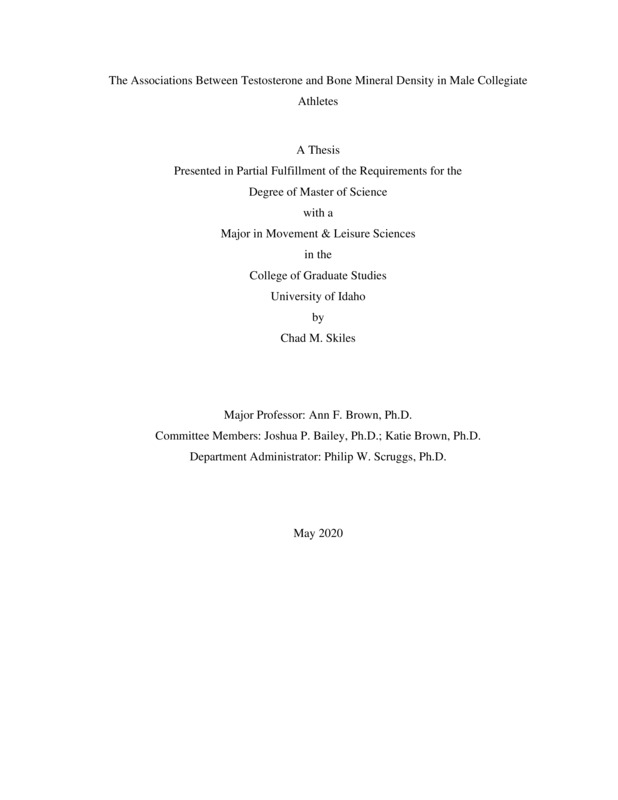The Associations Between Testosterone and Bone Mineral Density in Male Collegiate Athletes
Skiles, Chad. (2021-05). The Associations Between Testosterone and Bone Mineral Density in Male Collegiate Athletes. Theses and Dissertations Collection, University of Idaho Library Digital Collections. https://www.lib.uidaho.edu/digital/etd/items/skiles_idaho_0089n_11864.html
- Title:
- The Associations Between Testosterone and Bone Mineral Density in Male Collegiate Athletes
- Author:
- Skiles, Chad
- Date:
- 2021-05
- Program:
- Movement & Leisure Sciences
- Subject Category:
- Kinesiology
- Abstract:
-
Testosterone (T) deficiency and low bone mineral density (BMD) are common symptoms among those experiencing Relative Energy Deficiency in Sport. However, a lack of research exists on the associations between T concentration and BMD in various male athletes. The purpose of this study was to assess the associations between T concentration and low BMD in male collegiate athletes. Male collegiate cross-country (CC) runners, club rugby (R) athletes, and collegiate track and field (TF) sprinters/jumpers, completed one lab visit at the end of their sports off-season. Participants arrived fasted (8 hours), abstained from exercise (12 hours), and arrived within 60 minutes of waking. Testing included completing an eating disorder risk questionnaire, a 24-hour dietary food recall, anthropometrics, 3 dual-energy x-ray absorptiometry (DXA) scans (whole-body, left femur, and lumbar spine), and collection of a saliva sample. Descriptive statistics were performed on dependent variables using measures of central tendency, variability, and frequencies. The statistical hypotheses were examined using analysis of variance (ANOVA), in order to compare the three athletic groups. A post hoc tukey test was then used to determine where the significant differences occurred. Pearson correlations were utilized to assess the associations between T and BMD at whole-body, left femur, left femoral neck, and lumbar spine among all the male athletes and for each sport. Significance was accepted at p≤0.05. Seven of the ten R athletes were considered to have a high risk of eating disorders because of their affirmative answer to extreme weight control behaviors. CC had a higher caloric intake than R but not TF (CC: 3,813±1,239 kcal; R: 2,402±589 kcal; TF: 3,117±647 kcal, p=0.005, p=0.278 respectively). CC had lower whole-body BMD when compared to R but not TF (CC: 1.21±0.03g/cm2; R: 1.32±0.07g/cm2; TF: 1.28±0.09g/cm2, p=0.007, p=0.365, respectively). There were no significant differences in T concentration between groups. There were no significant associations between T concentration and BMD in CC and TF but R had significant associations between T concentration and whole-body (r=0.635, p=0.049), Left femur (r=0.671, p=0.034), and left femoral neck BMD (r=0.686, p=0.028). Our findings support previous research findings demonstrating low BMD in endurance runners compared to other athletes. However, no associations were observed between T and BMD except for in R athletes. T may not be a great predictor of BMD in male collegiate athletes.
- Description:
- masters, M.S., Movement & Leisure Sciences -- University of Idaho - College of Graduate Studies, 2021-05
- Major Professor:
- Brown, Ann
- Committee:
- Brown, Katie; Bailey, Joshua
- Defense Date:
- 2021-05
- Identifier:
- Skiles_idaho_0089N_11864
- Type:
- Text
- Format Original:
- Format:
- application/pdf
- Rights:
- In Copyright - Educational Use Permitted. For more information, please contact University of Idaho Library Special Collections and Archives Department at libspec@uidaho.edu.
- Standardized Rights:
- http://rightsstatements.org/vocab/InC-EDU/1.0/

